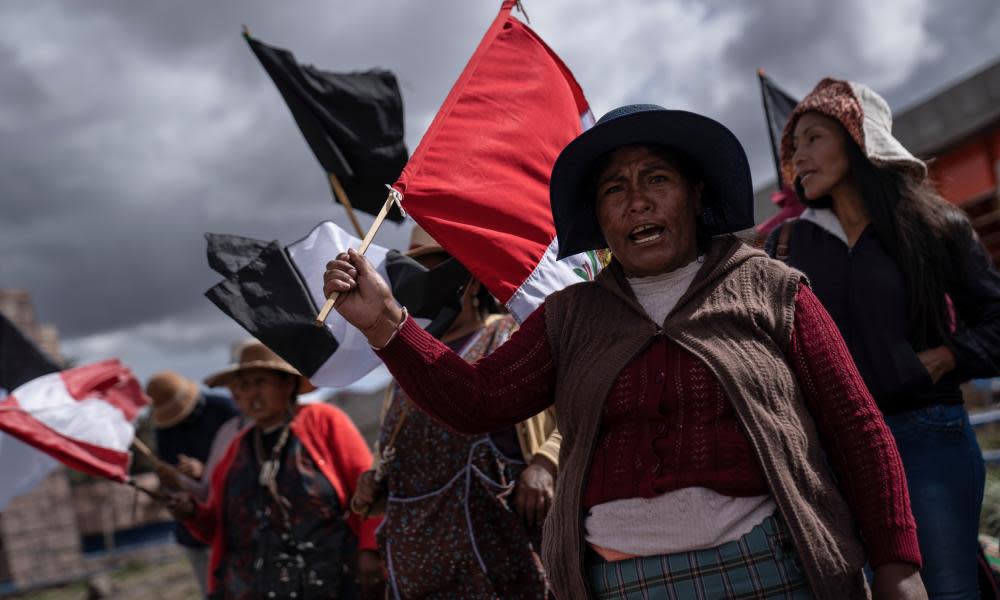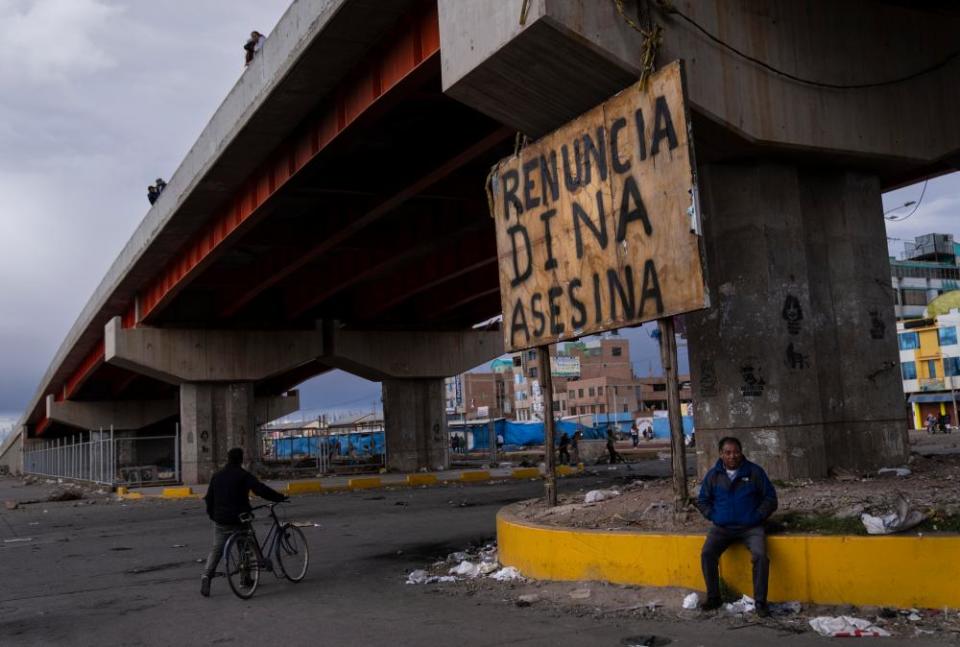‘My city is destroying itself’: Juliaca under siege as death toll rises in Peru’s uprising

Burning pyres of rubbish and bullet-pocked walls. Troops holed up in the airport with AK-47s and riot shields, waiting for a truce that has no date to come. A mayor holding court behind the broken windows of a vandalised city hall.
“I feel that my city is destroying itself. It is bloodstained. It is wounded,” lamented Oscar Cáceres as angry protesters gathered outside his municipal headquarters to demand political change and justice for the 17 people killed here during the most deadly day of violence in the two-month uprising against the government of Peru.
The political upheaval in South America’s fourth largest country has given the Andean city of Juliaca – the biggest in the southern department of Puno – the atmosphere and appearance of a war zone.
Near the pulverised international airport – the scene of ferocious clashes between protesters and security forces on 9 January, during which 17 people were killed – a graffiti artist has left a message for the city’s almost invisible authorities. “El Pueblo Manda” – “The People are in Charge,” it says.
Spend time in Juliaca and it is impossible to disagree.
During three days in the conflict-stricken city, only once did the Observer see members of the police or military outside the emergency command centre that has been set up at the international airport, which is named after Manco Cápac, the founder of the Inca civilisation.
Instead, Juliaca’s barricaded streets have been taken over by teams of anti-government rebels who have been in open revolt against president Dina Boluarte since early December when her leftist predecessor, Pedro Castillo, was removed from power and arrested after allegedly attempting a coup.

“We will stay here until this lady resigns,” one female objector shouted of Boluarte as she guarded a roadblock of burning tyres and cardboard boxes this week during the latest day of protests.
As the woman spoke, a male protest leader, who declined to give his name, arrived to voice his fury that so many protesters had been gunned down “like animals” by security forces since the uprising began. So far at least 59 people have reportedly been killed, including one police officer.
“My friend, it was here in Puno that the Inca empire was born – and that is what gives us courage. We have the blood of Pedro Vilcapaza and the blood of Túpac Amaru,” the man said of the two 18th-century Indigenous rebels. “We must fight on … and we will fight on,” he added, calling for Russia or the European Union to send weapons to the unarmed rebels.
Speaking outside the deactivated airport – whose entrance was protected by 10 policemen, seven orange traffic cones, four plywood panels and two heavy-eyed stray dogs – the army general in charge of reclaiming control of Juliaca voiced exasperation at the “shattering” of this city of 300,000 residents.
General Manuel Alarcón Elera, the head of Peru’s fourth mountain brigade, said his soldiers had been tasked with clearing the blockaded roads in the highlands around Juliaca in the coming days. But asked when normality might return, the general was stumped. “That’s a really complicated question,” said Alarcón. “I don’t believe there is an answer to it.”
A solution to Peru’s political crisis looks equally elusive, nearly two months after it began on 7 December when Castillo’s dramatic downfall saw his vice-president and former left-wing ally, Boluarte, take power.
The campesino rebels, who have locked down huge swaths of the Andes, have made four main demands if their roadblocks are to be dismantled: the resignation of Boluarte, who they say has been co-opted by the right, the dissolution of congress, fresh elections and the rewriting of Peru’s 1993 constitution, which was enacted during Alberto Fujimori’s authoritarian 10-year presidency and is blamed for profound inequality.
Some, although not all, also call for Castillo – a former unionist who was elected in 2021 promising to rule for Peru’s disenfranchised rural poor but faced a succession of corruption accusations – to be released and returned to power.
Deep-rooted rural anger at the neglect by Peru’s largely white, Lima-based political elites has been exacerbated by the killing of so many protesters – the majority in agricultural backlands, such as Puno, where the profits of gold and copper mining have failed to reduce poverty.

The names of some of the victims have been plastered on to the front of Juliaca’s baroque church opposite city hall, which demonstrators attacked 24 hours after the carnage at the airport on 9 January.
“The streets are stained with blood,” Carolina Machaca Mamani, a local nurse, yelled as she visited the grave of a colleague, Marco Antonio Samillán Sanga, on the city’s dilapidated outskirts.
Samillán Sanga, a 30-year-old trainee doctor, was at the airport with a group of volunteer medics when hundreds of protesters attempted to seize control of the runway to stop reinforcements being flown in. Witnesses say he was shot through the heart by police as he attended to a boy who had inhaled tear gas.
Bullets have gouged fist-sized chunks out of walls on Independence Avenue, the litter-strewn road that runs past the runway and where demonstrators tore down the airport’s perimeter fence before security forces repelled them with tear gas and live ammunition.
At a nearby intersection, a giant signboard hanging from a bridge reads: “Resign Dina you murderer.”
The Peruvian government has, without offering evidence, cast the demonstrators as organised gangs of terrorists and vandals whose insurgency is being supported by drug traffickers, illegal mining mafias and Bolivian leftists. Rightwing voices, also without proof, have alleged the insurrection is part of a leftwing conspiracy funded by Cuba and Venezuela.
But protesters reject those portrayals and claim authorities are trying to silence their legitimate calls for political change with guns.
Last month, the EU said it deplored the large number of casualties in the protests – which include a Juliaca policeman found burned to death – and condemned the “widespread acts of violence, as well as the disproportionate use of force by security forces”.
“I feel a mixture of pain, rage and impotence … life is worth nothing,” said Daisy Milagros, a 22-year-old student, as she taped a poster denouncing the killings to the gates of Juliaca’s church. “The order is to shoot. It is forbidden to think,” said the poster’s slogan, framed by cartoons of two bomb-throwing zombie policemen.
The violence has brought back painful memories of the 12-year war waged by communist Sendero Luminoso (Shining Path) guerrillas between 1980 and 1992, when an estimated 70,000 Peruvians lost their lives and hundreds of thousands fled to the cities to escape the bloodletting in the Andes.
Samillán Sanga’s brother, Raúl Constantino, said the last time he had seen Juliaca in such a state of turmoil was the early 1990s, during the dying days of what writer Alma Guillermoprieto called Peru’s years of “rage and insane murder”.
“When I was nine it was similar,” he said. “There were bombs. Roadblocks. There was no food, there were queues everywhere to buy kerosene … There was a curfew at night so you couldn’t leave your home … It was so, so sad.”

Cáceres said he had “never seen such chaos or such conflict” and compared the shutting down of Juliaca by protesters to a hunger strike, which was slowly killing the very city it was supposed to help.
“It’s so hard – and it’s so very difficult to understand,” said the mayor, who warned Juliaca had run out of chlorine needed to purify its water supply because of the airport’s closure to commercial flights. The scores of roadblocks encircling the city mean Juliaca is also suffering shortages of food, petrol and gas.
Cáceres said he understood rural indignation at the “scandalous” airport crackdown and Lima’s political establishment – which had failed to address the longstanding social problems blighting his region. He hoped Boluarte – whom he declared a persona non grata in Juliaca – would resign to avoid the city’s economic collapse and further bloodshed.
“It would be so sad for everyone if we ended up having a civil war or fighting each other. There would be a slaughter. We cannot accept this,” said Cáceres, who admitted Juliaca had become a city “without security”.
Boluarte has declined to stand down but last week urged Peru’s profoundly unpopular congress to bring elections forward to this year in order to defuse the escalating crisis. In an illustration of the political dysfunction that has seen Peru get through seven presidents in the last six years, congress has repeatedly shunned those calls.
In Juliaca, where black flags of mourning hang from shuttered shops and homes, many fear the worst violence is still to come as troops prepare to confront demonstrators who have blocked nearly 100 roads and highways across Peru, causing hundreds of millions of dollars of economic losses.
Last week, as the city braced for another day of confrontations, volunteer nurse Yulisa Luque Jacho took to the streets in a white builder’s helmet and blue medical scrubs with her name, date of birth and blood type written on the right sleeve with a marker pen.
“The government is sending the Peruvian army in and the people will react in some way – and I fear something very violent will happen because of all the rage,” said the 22-year-old medic as her team waited to be summoned to the frontline.
Thirty-six hours later, as Juliaca’s nightly curfew came to an end at 5am, the Observer saw police on the streets for the first time in three days.
Just around the corner from the mayor’s office, a cluster of officers huddled in the darkness beside by two white SUVs. Through the pre-dawn shadows the body of a man could be seen at their feet.

 Yahoo Movies
Yahoo Movies 
